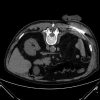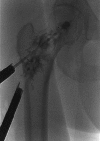Metastatic Osseous Pain Control: Bone Ablation and Cementoplasty
- PMID: 29249856
- PMCID: PMC5730439
- DOI: 10.1055/s-0037-1608747
Metastatic Osseous Pain Control: Bone Ablation and Cementoplasty
Abstract
Nociceptive and/or neuropathic pain can be present in all phases of cancer (early and metastatic) and are not adequately treated in 56 to 82.3% of patients. In these patients, radiotherapy achieves overall pain responses (complete and partial responses combined) up to 60 and 61%. On the other hand, nowadays, ablation is included in clinical guidelines for bone metastases and the technique is governed by level I evidence. Depending on the location of the lesion in the peripheral skeleton, either the Mirels scoring or the Harrington (alternatively the Levy) grading system can be used for prophylactic fixation recommendation. As minimally invasive treatment options may be considered in patients with poor clinical status or limited life expectancy, the aim of this review is to detail the techniques proposed so far in the literature and to report the results in terms of safety and efficacy of ablation and cementoplasty (with or without fixation) for bone metastases. Percutaneous image-guided treatments appear as an interesting alternative for localized metastatic lesions of the peripheral skeleton.
Keywords: ablation; bone metastasis; cementoplasty; interventional radiology; pain.
Figures





References
-
- Coleman R, Body J J, Aapro M, Hadji P, Herrstedt J; ESMO Guidelines Working Group.Bone health in cancer patients: ESMO Clinical Practice Guidelines Ann Oncol 20142503124–137. - PubMed
-
- Ripamonti C I, Santini D, Maranzano E, Berti M, Roila F; ESMO Guidelines Working Group.Management of cancer pain: ESMO Clinical Practice Guidelines Ann Oncol 20122307139–154. - PubMed
-
- Dennis K, Makhani L, Zeng L, Lam H, Chow E. Single fraction conventional external beam radiation therapy for bone metastases: a systematic review of randomised controlled trials. Radiother Oncol. 2013;106(01):5–14. - PubMed
-
- Chow E, DeAngelis C, Chen B E et al.Effect of re-irradiation for painful bone metastases on urinary markers of osteoclast activity (NCIC CTG SC.20U) Radiother Oncol. 2015;115(01):141–148. - PubMed
-
- Rosenthal D, Callstrom M R. Critical review and state of the art in interventional oncology: benign and metastatic disease involving bone. Radiology. 2012;262(03):765–780. - PubMed
Publication types
LinkOut - more resources
Full Text Sources
Other Literature Sources
Research Materials

